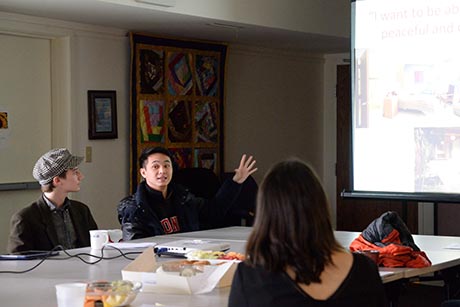Course helps hone design for Hospicare expansion
By Dani Corona

Cornell students are advising on the addition of a new wing for an Ithaca health care facility, examining how research-based design can support the needs of patients, staff and visitors in hospice and palliative care settings.
Led by Paul Eshelman, professor of design and environmental analysis, seven students from a variety of Cornell majors last month presented their ideas to Dale Johnson, executive director of Hospicare and Palliative Care Services of Tompkins County, and principals from Ithaca’s HOLT Architects, the firm leading the expansion.
Since palliative care manages pain but does not try to cure illness, the students recommended an environment tailored to maximize the comfort of patients and their families. For instance, they suggested that patients use remotes to change their room’s environmental settings, such as adjusting curtains without leaving bed, and adding bath towels in the patient’s favorite color and other personal touches.
“[The students] really hit the heart of what issues surround end-of-life care,” said Sarah Galbreath, an architect with HOLT. “I loved their ideas regarding flexibility and control for the patient – concepts for us to chew on and consider.”
Reading case studies prepared by Eshelman and Rana Zadeh, assistant professor of design and environmental analysis, students examined common issues in palliative and hospice care before developing a plan that emphasizes the psychosocial needs of patients and families.
“As life nears its end, there are changing needs and changing people,” said Michelle Correa ’15, a human biology, health and society student in the College of Human Ecology. “Facilities must accommodate for that, all while instilling a sense of being and comfort. Our recommendations are concrete, with spatial configurations to show how rooms can be shaped to support this notion of continuous change throughout the process of dying.”
For Correa, who hopes to work in health care administration or public health, developing and delivering these recommendations was very eye opening. “It is valuable having this knowledge of what people want at the end of their life. It can be as simple as adding a light or view of nature, which many think is expensive but it’s not—there are ways for design to be efficient, sustainable and caring.”
Palliative care, said Eshelman, incorporates not just pain treatments but other patient needs – spiritual, emotional, social and familial. The collaboration allowed students to learn a valuable lesson in health-care facility design: how to focus on the patient experience.
“This was a good opportunity for students to help inform a complex design process,” said Eshelman, “and a chance for all to think ahead about what might be needed for this community.”
The architects and planners are taking the students’ recommendations into the design phase, incorporating some of their ideas into sketches for the new wing.
“I really appreciated that [the students] approached it philosophically, about what is good rather than a matter of brick and mortar, and got into the minds of people who will experience it,” said Johnson, who has previously partnered with Cornell on hospice and palliative care research. “It provides a great basis as we step back and dig deeper into the design.”
Dani Corona ’15 is a student communications assistant for the College of Human Ecology.
Media Contact
Get Cornell news delivered right to your inbox.
Subscribe